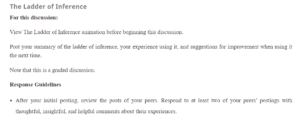The Ladder of Inference
The ladder of inference describes a thinking process that people follow from the point of gaining information to the point of making a final decision and taking action. Without realizing it, people begin their decision-making process by first observing data. From the data, one goes ahead to select the data that is to be analyzed to make conclusions. In the process of decision-making, people proceed to make assumptions about the data that they selected. They make conclusions with the help of the data and the assumptions (Tompkins & Rhodes, 2012). People then include their own personal beliefs about their conclusions and take action based on those beliefs. The issue with this process is that it can lead to poor judgment. The beliefs and assumptions made in the decision-making process influence the ability to be rational in the process. For instance, the data selected is affected by the beliefs that one may have about the decisions that they are trying to make (Larcher, 2007). An example is when someone has a negative belief about a group of people; hence, when making judgments about the group, they will choose data that confirms their negative beliefs and ignore the positive data. People’s assumptions can also be negatively influenced by the assumptions and beliefs that affect the decision-making process. Therefore, it is important to recognize these biases when using the ladder of inference in making decisions.
My Experience Using the Ladder of Inference
Although I do not consciously make the decision to use the ladder of inference, I end up using this process to evaluate the data that I have observed and make the final decision. I frequently experienced the challenges that the ladder of inference brings about. In particular, I am notorious for confirmation bias. For example, if I believe that a certain product hurts the skin, I will choose the data that confirms my suspicions of the effects of that product. This eventually influences my action, which is stopping the use of that product and advising people to do the same. I have to find ways to deal with such biases to expose myself to better decision-making. The following are suggested actions that can be taken to improve the effectiveness of the ladder of inference in decision-making.
Suggestions for Improvement
One of the actions that can be taken is self-awareness. It is important to be aware of one’s assumptions and beliefs and how they affect decision-making. This awareness helps someone to be active in avoiding the influence of beliefs on actions that are taken. The second action that can be taken to avoid these limitations is to always seek contrary information. When presented with data, evaluating information from all sides of the argument is important. This helps to fully examine all available data before making the final inferences. The action ensures that the final decision and action made is not based on biased data.
References
Larcher, B. (2007). Up and down the ladder of inference. HORIZONS-PENRITH-, 37, 7.
Tompkins, T. C., & Rhodes, K. (2012). Groupthink and the ladder of inference: Increasing effective decision making. The Journal of Human Resource and Adult Learning, 8(2), 84.
ORDER A PLAGIARISM-FREE PAPER HERE
We’ll write everything from scratch
Question 
The Ladder of Inference
For this discussion:
View The Ladder of Inference animation before beginning this discussion.

The Ladder of Inference
Post your summary of the ladder of inference, your experience using it, and suggestions for improvement when using it the next time.
Note that this is a graded discussion.
Response Guidelines
- After your initial posting, review the posts of your peers. Respond to at least two of your peers’ postings with thoughtful, insightful, and helpful comments about their experiences.
Resources
- The Ladder of Inference Scoring Guide.